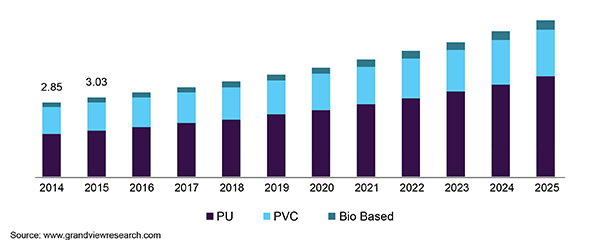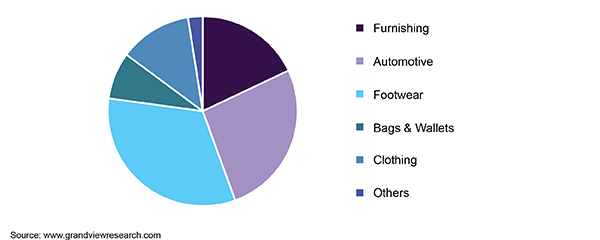
Our Location
Flat 10, The Old Picture House, 30 Oakbank Road, Southampton, SO19 9DT
Email: Info@oursophia.co.uk
Phone: +44(0)191 206 4194
The global synthetic leather market size was valued at USD 25.61 billion in 2017 projected to expand at a CAGR of 7.4% during the estimated period. Globally increasing demand from footwear sector is expected to be a key factor propelling the overall market growth. Comprised of a cloth base coated with a synthetic resin, artificial leather serves as a suitable alternative, which is also augmenting its demand in various applications.
It is used in various applications including fabrics, footwear, clothing, upholstery, and others where leather-like finish is required and the material is unusable, unsuitable, and cost-prohibitive. The production process has evolved over the past few years for the shell coating to go on top of the synthetic polymer blend.

The global demand has seen a paradigm shift due to rising application across furnishing, automotive, clothing, bags and others. Thus, manufacturers are focusing on increasing their production capacities. The global market is fragmented and is led by a few companies. This has resulted in high entry barriers as these manufacturers are emphasizing on forward and backward integration across the value chain to improve their efficiency and overall productivity.
Emerging regional markets, such as China, India, Brazil, Malaysia, Thailand, and Vietnam are expected to play a major role in the product demand. Extensive usage of synthetic leather in the footwear industry in these and several other regional markets is also expected to contribute to the growth of global industry over the next few years.
Polyurethane (PU) has been witnessing promising growth, in terms of product quality, variety, and yield. It is the largest product segment and is also expected to observe the fastest growth during forecast years. Polyurethane is waterproof, softer and lighter than real leather, can be dry cleaned and torn easily than real hides. It also remains unaffected from sunlight.
It is an eco-friendly substitute to vinyl-based products as it does not emit dioxins. All these factors are expected to augment its demand further. The PVC product segment is expected to witness slow growth over the forecast period. PVC was the first form of synthetic leather created in 1920. It was initially produced with carcinogenic chemicals and proved to be an ideal material for applications in furnishing and household items.
PVC faced huge competition from PU as PVC gave a sticky feel and was unable to retain the body heat. As a result, its demand decreased in clothing and bags application segment. Bio-based product is comprised of polyester polyol and has 70-75% renewable content. It is softer and has better scratch resistance properties than PU and PVC.
Key companies in the global market are focusing on the development of new products through collaboration with polyols producers. Rapid industrialization and constant R&D will continue to supplement the segment growth in upcoming years.
Footwear emerged as the largest application segment in 2017. Its application is getting nearer to genuine leather, which is increasing replacing the applications in handbags, briefcases, car furnishings, and clothing. Rising income levels and economic growth, especially in emerging nations, has fuelled the demand for footwear. In addition, the segment is also led by variations occurring in climatic conditions of different regions, which needs different types of footwear.
Increasing athleisure trend of incorporating athletic shoes in daily lifestyle is also expected to propel the segment growth. The price of a faux leather footwear products is three times cheaper than the ones made from animal hide, which also boosts the segment development. Furnishing industry is also one of the major application areas for synthetic leather as it has become more affordable than animal hides.

There is a wide range of synthetic leather materials available in market that serve varied requirements of the furnishing industry, in terms of colour, texture, and fabric look. Moreover, such artificial alternatives can also be used in marine furnishing as it is salt water resistant. Faux leather is used in cars, trucks, motorcycles, buses, and agricultural vehicles as it is lighter than animal hides.
Polyurethane is the most-widely used material in automotive sector as it is non-sticky and softer than other products. The bags and wallets segment is also estimated to have a significant growth over the coming years due to high product demand. The usage of faux leather enables the production of lightweight, breathable, scratch- and water-proof, and easy-to-maintain bags.
With the evolving textile technology, consumers are preferring vegan fashion, which refers to adopting non-leather products. Thus, synthetic leather serves as the most suitable alternative in textile applications. PU synthetic leather is also used in clothing where it is used to create spandex and to add buoyancy to competitive swimsuits.
Asia Pacific led the global market in 2017 and is projected to grow further on account of rapidly expanding footwear and automobile industries. China, India, and South Korea are expected to be the major growth-driving economies in APAC. Rising disposable income coupled with increasing population will provide numerous opportunities for the market. China, in particular, constitutes around 25% of the global production.
North America and Europe are also expected to witness significant growth owing to rising demand for cruelty-free products. Moreover, rising awareness and stringent regulations regarding animal rights in several countries in these regions have been encouraging the usage of synthetic leather. Supply-demand gap in natural leather industry is another major factor that has made manufacturers to opt for artificial alternatives.
Source: Grand View Research